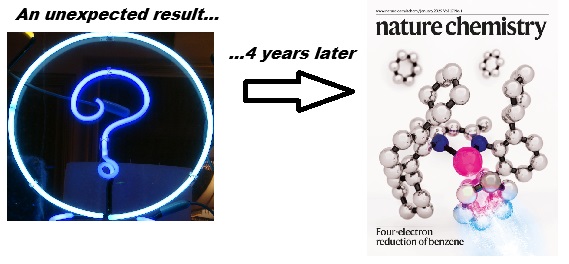Research
Published 18 March 2025There and Back Again: Submission to Acceptance in Nature Chemistry
Back in 2021 my first year PhD student, Georgia Richardson, came to me with a result that didn’t make sense...
Apparently during the routine synthesis of one of her complexes something seemed to have gone wrong and the extremely stable and unreactive solvent she had performed the reaction in, seemed to have reacted with her complex. Despite the fact that I immediately dismissed the result as impossible, this started our 4-year journey to publication in Nature Chemistry.

An artists rendition from unexpected experiment to a Nature Chemistry paper. "Question Mark Squircle" by Xurble is licensed under CC BY 2.0. The Nature Chemistry cover is reproduced with permission from the authors.
After recreating this result several times, it became clear that we had in fact reacted our simple starting material with the extremely stable and common solvent benzene. Specifically, Georgia had reduced benzene to its tetra-anion form using a simple samarium alkyl complex and we were excited. This was the first time this type of reactivity had ever been seen!
"As a scientist, doing something for the first time is always exciting but these types of results are usually only interesting to scientists within that specific field of research. But, we also found that the benzene tetra-anion was important!"
The benzene tetra-anion obeys a rule that all undergraduates in the physical and chemical sciences are taught, Hückel’s Rule for predicting aromaticity. This rule is essential for predicting how specific systems will behave from new materials to biological reactions. A rule that was essential in the work of the New Zealand chemist and Nobel Prize-winning Alan MacDiarmid, the namesake of the building in which we were conducting our research at Te Herenga Waka – Victoria University of Wellington. The benzene tetra-anion was predicted to exist by Hückel’s Rule, but it was thought impossible to isolate as it would be too unstable. Well, we managed to isolate it by a very happy accident. More importantly, this is the sort of result that can change how scientists think about these complexes, even how undergraduates are taught. The sort of result that could be published in Nature Chemistry – the premier journal for the publications in the physical and chemical sciences.
Needless to say, we set about collecting what we considered all the necessary data to prove we had actually isolated the benzene tetra-anion and how we had achieved it. To achieve this, we worked with scientists across New Zealand that supported and enabled our research. At the end of 2023 we submitted our manuscript to Nature Chemistry and as a preprint on their platform Research Square and held our breath. What followed was a series of small celebrations, for the work we had done, for submitting and then when the editor informed us that the manuscript was sent out to be reviewed.
Six months later we received our reviewer reports, and we held our breath again. In summary, Reviewers 1 and 3 were happy and Reviewer 2 was not. Why is it always Reviewer 2?! All up, while the consensus was our work was correct and on the right track, we were left with lots of additional work to support our findings. We could either carry out the additional work or publish our findings somewhere else. This presented a problem. By now, Georgia had finished her PhD and graduated as Dr Richardson with a job lined up as a Senior Scientist for a start-up company and the funding for the project had finished. Fortunately, Georgia wasn’t due to take up her role for three months and after a successful application to the MacDiarmid Institute for funding we set out to collect the additional data. Three busy months later we submitted our revised manuscript and had another small celebration. One review round later and a few minor corrections to the manuscript itself and we were accepted, and rather than a celebration, there was a collective sigh of relief.
Needless to say I have learned a lot from of this 4-year process. First and foremost, I learned what is required to publish in premier journals. Compared to the more typical subject specific journals I publish in, the burden of proof to unequivocally demonstrate what you have reported is in fact correct is unbelievably high. This then naturally leads to research projects running into multiple years before you even reach the long and arduous review reprocess. This then raises several questions: Can you afford to wait years, often beyond a funding cycle, for the possibility of a high-level publication? Do you have the necessary equipment available to complete the project? Do you have the network of collaborators that can provide equipment or techniques required for the project but not available to you? Do you and your team have the mental capacity to deal with the whole process? And finally, in a landscape of increasingly uncertain research funding, which is often ‘boom or bust’, and increasing pressure from institutions on academics to ‘perform’ would I do it again? My answer would be, if you can say yes to all these questions at the start of the project, despite everything, it's 100% worth it.
Additional information: Four-electron reduction of benzene by a samarium(II)-alkyl without the addition of external reducing agents
RESEARCHER
Dr Mat Anker
ORGANISATION
Te Herenga Waka Victoria University of Wellington
FUNDING SUPPORT
Rutherford Discovery Fellowship and a Marsden Fund Fast-Start Grant
CONTRACT OR PROJECT ID
RDF-VUW2204, MFP-VUW2116
